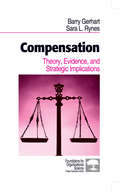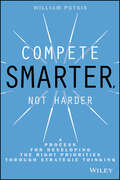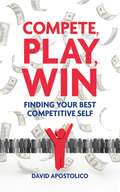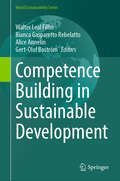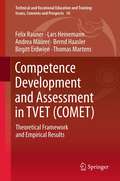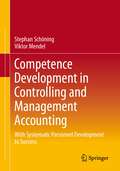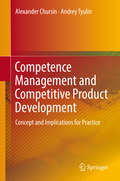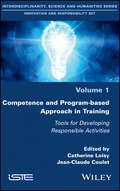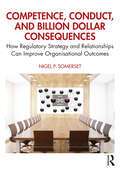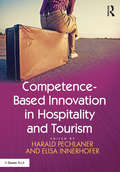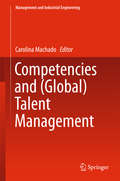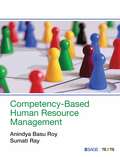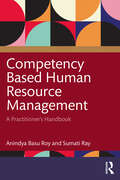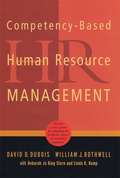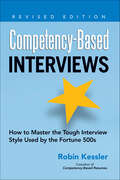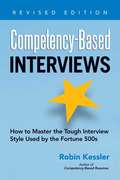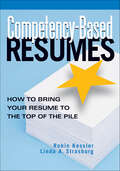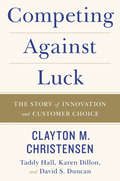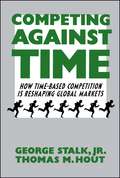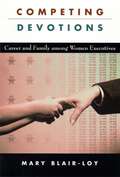- Table View
- List View
Compensation: A Balanced Approach
by Beverly J. DeMarr Vicki Taylor Claudia J. FerranteCompensation: A Balanced Approach 1e takes an applied approach to covering compensation systems and practices by balancing theory and research with exercises and applications. Each chapter looks at compensation from both the employer and employee perspective, giving students a more holistic understanding of the role total rewards play in an organization. Authors Beverly J. DeMarr, Vicki Fairbanks Taylor, and Claudia J. Ferrante help students develop the ability to think critically and ethically about compensation decisions and their effects on both employers and employees.
Compensation: Theory, Evidence, and Strategic Implications
by Barry Gerhart Sara L. RynesCompensation: Theory, Evidence, and Strategic Implications provides a comprehensive, research-based review of both the determinants and effects of compensation. Combining theory and research from a variety of disciplines, authors Barry Gerhart and Sara L. Rynes examine the three major compensation decisions–pay level, pay structure, and pay delivery systems. provides a comprehensive, research-based review of both the determinants and effects of compensation. Combining theory and research from a variety of disciplines, authors Barry Gerhart and Sara L. Rynes examine the three major compensation decisions–pay level, pay structure, and pay delivery systems.Primarily intended for graduate students in human resource management, psychology, and organizational behavior courses, this book is also an invaluable reference for compensation management consultants and organizational development specialists.
Compete Smarter, Not Harder
by William PutsisHow to compete in the right space for greater profitability and growthThe Internet, mobile technology, the ubiquity of information and the availability of big data have dramatically increased the speed and impact of success and failure. Companies today know that they must be competitive, but precisely where, and more importantly how, to compete is not always easy to identify--until now. Compete Smarter, Not Harder explains how to prioritize market opportunities so that a company's strengths in one area can be leveraged across multiple markets. Using cutting-edge academic research and extensive industry practice, author William Putsis outlines the strategic decisions needed to determine which space provides the best margins, overall profitability, and growth potential.Details a step-by-step process for strategic prioritization, from strategic market selection to the tactics of execution, providing competitive advantage across marketsWritten by Doctor William Putsis, a professor of marketing, economics, and business strategy at the University of North Carolina at Chapel Hill, who has consulted and led executive development efforts with leading companies throughout the worldPrioritize with conviction. Make absolutely sure that all of your hard work goes toward the right space.
Compete, Play, Win: Finding Your Best Competitive Self
by David ApostolicoThis book is a sociological examination of competition and the competitive drive, told from the viewpoint of a competition freak. The author explores the energy and force behind the need to compete, and what the consequence of that need is. In the chapter "Sperm Wars," Apostolico discusses conception as the beginning of the competitive nature of humans, while also discussing the competition for a mate that precedes it. Through this, he sets up the idea of a biological necessity for competition and how evolution has modified and enhanced that drive. In a later chapter called "Competitive Nature," Apostolico participates in as many competitive endeavors as possible (eating contests, drag races, dog shows, etc.) and answers a set of 10 questions about each, concluding with, "Can a competitive junkie ever truly feel satisfied?"
Competence Building in Sustainable Development (World Sustainability Series)
by Walter Leal Filho Bianca Gasparetto Rebelatto Alice Annelin Gert-Olof BoströmThis book aims to provide a comprehensive guide to understanding and implementing the competencies required for sustainable development. In recent years, the need for sustainable development has become increasingly evident across various sectors globally. Climate change, resource depletion, and social inequalities pose significant challenges that demand urgent and comprehensive action. The concept of sustainable development is not merely an environmental concern; it encompasses economic, social, and governance dimensions, necessitating a holistic approach to address these interlinked issues effectively. It seeks to bridge the gap between theoretical frameworks and practical applications, offering insights that are relevant to policymakers, educators, business leaders, and individuals committed to sustainability. The genesis of this book lies in the recognition that achieving sustainable development is contingent upon building and enhancing competencies at multiple levels—individual, organizational, and societal. Competence in sustainable development involves a combination of knowledge, skills, attitudes, and values that empower individuals and organizations to contribute effectively to sustainable goals. One of the key strengths of this book is its multidisciplinary approach. Sustainable development is inherently interdisciplinary, requiring insights from environmental science, economics, social sciences, and management studies. The contributors to this book bring diverse perspectives and expertise, ensuring a rich and nuanced exploration of the subject matter. Furthermore, this book emphasizes the importance of education and training in building competencies for sustainable development. It discusses innovative educational approaches, curricula development, and the role of institutions in fostering a culture of sustainability. The role of technology and digital tools in enhancing sustainable practices is also highlighted, recognizing their potential to drive significant positive change.
Competence Development and Assessment in TVET: Theoretical Framework and Empirical Results (Technical and Vocational Education and Training: Issues, Concerns and Prospects #16)
by Felix Rauner Lars Heinemann Andrea Maurer Bernd HaaslerThe transferability of vocational education and training qualifications across international borders is a live issue in this heterogeneous field. Key to this goal is defining a common methodology for measuring vocational competences. This publication sets out a proposal for just that, based on the results of a pilot project known as 'COMET' on competence diagnostics in the field of electrical engineering. The study deploys longitudinal analysis to explore issues of competence development, the development of vocational identity, and occupational commitment. It focuses on two discrete occupational profiles in electrical engineering in an ambitious test of a model currently applied to other professions as well. The model's success in its first phase is detailed in the second part of the volume, where the authors show that the transfer of the competence framework into an empirical model was successful. They also demonstrate that the methodology can be applied to designing and evaluating vocational education and training processes, making the material relevant to VET teachers and trainers as well as academics. With its first section comprising a full description of the theoretical framework, this book is a significant step forward in an urgent task facing administrations, labor forces and employers around the world. The achievement is in proportion to the notorious complexities of a field whose diversity makes tough demands on large-scale methods of assessment.
Competence Development in Controlling and Management Accounting: With Systematic Personnel Development to Success
by Stephan Schöning Viktor MendelThe book is considered a guideline for systemic personnel development in controlling of nationally and internationally active companies on the basis of a targeted development of competencies. In particular, the challenges posed by digitalization and globalization are considered and substantiated with the help of empirical studies. Employees and managers in controlling as well as HR managers in companies gain a deeper understanding of the necessity and the components of systematic personnel development. The goals are the formation of high-performance teams in controlling as well as the identification of personal career paths on the way to top management tasks as CFO. The focus of the personnel development model is on the transfer of the competence-oriented development approach, which, in addition to the traditionally considered technical and methodological competencies, also takes into account social and personal competencies as well as additional digital and intercultural competencies. The book is rounded off by a survey of the current situation, the definition of a target situation to be aimed at, the discussion of suitable further training measures and the monitoring of the level of competency achieved, and illustrates concrete career concepts.
Competence Management and Competitive Product Development: Concept And Implications For Practice
by Alexander Chursin Andrey TyulinThis monograph provides theoretical and practical perspectives on competency management as a key resource for producing competitive products. The authors develop and substantiate a law of dependence between competencies and emergence of new markets, and describe the practical aspects of developing competencies in high-tech companies. Further, they develop economic and mathematical models for managing the competitive advantages of a company based on competencies. Using these models, they present a method for evaluating and ranking core competencies, as well as for multi-criteria ratings of human potential efficiency. The book also discusses the mechanisms of competitiveness management based on a conceptual model of a competence center network.
Competence and Program-based Approach in Training: Tools for Developing Responsible Activities
by Catherine Loisy Jean-Claude CouletThe controversies that have developed in recent years in the field of education and training around program and competency-based approaches are not without reminiscent of those which are at the origin of a reflection on the question of methods to monitor, control, organize and shape innovation in science and technology "and led to the emergence of the notion of responsibility for innovation and research "(Pellé & Reber, 2015). This book is clearly part of this type of approach. Starting from a current state of play on the issues and controversies raised by curricular and competency-based approaches (Chapters 1 and 2), this book aims at presenting new theoretical frameworks, allowing to account for the processes implied by the implementation of these pedagogical innovations and, in particular, those which, at the very heart of the skills mobilized, promote a "responsibility" dimension. Based on a developmental approach to individual and collective competencies and their evaluation (Chapters 3, 4 and 5), it attempts to show how this approach can mobilize educational practices on strong societal issues, such as "sustainable development "(Chapter 5). Lastly, it aims to provide theoretical and practical benchmarks to help engage educational teams and institutions in these innovative and responsible approaches by providing a coherent framework for doing so (Chapters 6, 7 and 8).
Competence, Conduct, and Billion Dollar Consequences: How Regulatory Strategy and Relationships Can Improve Organisational Outcomes
by Nigel P. SomersetThis practical guide to understanding how regulators build insight and form judgements will help organisations to develop their strategy and approach to engagement and to improve their regulatory outcomes. From robot-assisted surgery and advances in stem cell technology, the explosion in use of social media and advances in computing power to the development of autonomous vehicles and digital environments such as the metaverse, these exciting developments present questions, invite debate and have implications. These rapid new developments also join a world described as being increasingly VUCA (volatile, uncertain, complex, and ambiguous), making industry-regulator relationships more important than ever to prevent consumer harm and to configure business success. This book is written for those who wish to build positive and progressive relationships with their regulators in these exciting times of rapid advancement. From developing their strategy, through to the practicalities of how to prepare and engage with regulators, readers are navigated through an ecosystem of insight to help build an understanding of what informs their regulator’s opinion and judgements. Underpinned with real-world experiences and examples, this book shows that, through clearer strategic focus and more effective relationships, organisations can refine their approach and build their relationships to drive mutually beneficial regulatory relationships that avoid negative consequences and unnecessary costs. Board members, executives, senior leaders, risk, compliance, legal professionals, regulators, and students of business, finance, and law will refer to this book again and again to guide holistic thinking about regulatory relationships and use the insights these can provide to help them calibrate their actions, activities, and progress.
Competence-Based Innovation in Hospitality and Tourism
by Elisa Innerhofer Harald PechlanerDr Pechlaner and Dr Innerhofer, the editors of Competence-Based Innovation in Hospitality and Tourism, argue that the industry operates within highly challenging and competitive environments. Changing environmental and market conditions continually force hotel businesses and service providers to offer their customers new and modified products and services, in order to remain competitive; those which respect value perceptions of markets and sustainable stakeholder reactions. This then raises the question of how innovations within this industry must be developed in order to achieve competitive differentiation. The book demonstrates that the development and analysis of successful innovation strategies should integrate the resource-based view and its advancements, the competence-based view, as well as the dynamic capabilities approach and the relational view. Resource-based strategic management approaches view the firm as a bundle of resources and competences. They point to the importance of firm-specific resources and competences in explaining variations in competitive positions and performance differentiation between companies. The challenge of hospitality and tourism is to develop resources and competences that drive innovations. This book will serve to advance the status quo of tourism research literature by combining innovation theories with network theories and tourism and destination development, by illustrating the development of cooperative competences and innovations in tourism and by showing, in a tailored way, how the challenge of the development of resources and competences that drive innovations in tourism can be managed.
Competencies and (Management and Industrial Engineering)
by Carolina MachadoThis book covers the main issues on the study of competencies and talent management in modern and competitive organizations. The chapters show how organizations around the world are facing (global) talent management challenges and give the reader information on the latest research activity related to that. Innovative theories and strategies are reported in this book, which provides an interdisciplinary exchange of information, ideas and opinions about the workplace challenges.
Competencies for HR Professionals
by Dave Ulrich Brian E. Becker Mark A. HuselidIf HR professionals are going to take full advantage of the lessons in this book on implementing a strategic HR architecture, they will have to broaden their professional competencies to include what the authors call strategic performance management. This chapter examines the skills HR professionals need to forge a strategic partnership with line management, reviewing examples from companies that have successfully honed those competencies.
Competency Based Human Resource Management
by Anindya Basu Roy Sumati RayAn analytics-based approach to competency modelling and assessment as the pivot for HRM Competency Based Human Resource Management presents a practice-oriented approach for building organizational competency at the workplace to achieve organizational goals. Useful for students and practitioners of HRM, this book adequately balances theory and illustrations to elucidate the application of analytics in competency modelling across varied industry domains and verticals. Along with methodology for developing reliable and valid psychometric tools for assessment, the book elaborately covers two most popular approaches - Assessment Centre and 360 Degree - in conjunction with relevant statistical tools. With more than three decades of industry and academic experience, the authors, through this textbook, aim to help readers gain conceptual as well as practical insight into competency modelling, competency assessment and the integration of competency models into HRM. Key Features: • Emphasis on how to design and roll out competency-based HRM applications. • Includes case studies and real-life examples. • Includes crucial post-implementation phase of a competency mapping project.
Competency Based Human Resource Management: A Practitioner's Handbook
by Anindya Basu Roy Sumati RayThis book balances theory and illustrations to elucidate the application of competency modeling across varied industry domains. The book provides a methodology for developing reliable and valid psychometric tools for assessment. The book elaborately covers two most popular approaches – assessment center and 360-degree assessment – along with their pros and cons and most importantly insights on which approach to apply where.This book will help readers gain conceptual as well as practical insights into competency modeling, competency assessment and the integration of competency models into Human Resource Management (HRM). Apart from covering all the relevant topics adequately, the book delves into analytics related to the design of competency models as well as the setting up of assessment systems. There is a chapter dedicated to designing psychometric tools for competency assessment advocating the use of statistical tools like tests of significance and test design concepts like item analysis, reliability and validity. There is another chapter dedicated to how a Human Resource Department can play a facilitator’s role in setting up a competency based HRM.The book would be useful for students, researchers and faculty of Business Management courses especially those specializing in Human Resource Management. It will be an invaluable resource for all HR practitioners from the industry who want to make competency based HRM work – either by modifying an existing competency model or setting up a new model.
Competency Mapping and Assessment: A Practitioner's Handbook
by Seema SanghiThis book provides an in-depth coverage on competency mapping and assessment centre and includes an extensive list of generic competencies, competency models for HR, leadership, model for future competency, automobile sector, and academic institutions and experiences of some consultancy assignments. It presents the complete know-how of developing a competency framework in detail for all practitioners and professionals. The volume examines ‘what, why, how’ on the subject and extensive support models that have been developed over years of research, consultancy, and training experience across private, public, and government sectors in India, Bangladesh, Saudi Arabia, Nepal, the UK, and other countries. The book has been designed to help scholars and practitioners to understand, develop, manage, and map competencies with their organizations. The chapters are illustrated with figures and tables, along with examples, for a better understanding. The glossary of job task analysis will be helpful in job analysis, which is one of the most important tasks in developing competency models.The volume would be useful to both the academic and corporate world. The students, researchers, and faculty of business management courses, especially those specializing in human resource management, will have an in-depth understanding of ‘What and Why’ of competency frameworks, models, and assessment centre. It will be an essential resource for corporates—public and private sectors—multinational organizations, staff training institutions, learning and development centres, consultancy firms, trainers, government and public service organizations, etc. to get a hands-on understanding of ‘How’ of developing competency framework, competency mapping and assessment centre in their organizations.
Competency Web: The Corporate DNA
by N. P. RajasekharanThe Competency Web is an inevitable tool and a process in the context of transformation and change. All organisations require this web that is configured to suit each company.
Competency-Based Human Resource Management: Discover a New System for Unleashing the Productive Power of Exemplary Performers
by William J. Rothwell Linda K. Kemp Deborah Jo King Stern David D. DuboisForce-fitting employees into a "job box" shortchanges both the employees and the organization, according to David Dubois and William Rothwell. The more effective method is to fit employee talents to the work that must be accomplished. Competency-Based Human Resource Management describes how to reinvent the human resource department so that job competencies, rather than job descriptions, become the foundation for all HR efforts. The authors show HR professionals how to identify the key competencies that distinguish best-in-class performers-or "exemplars"-from average performers and use them as the basis for all HR functions, including planning, recruiting and selecting, training and performance development. This new model of performance management unleashes the power of exemplary performers across all job categories, resulting in enhanced employee satisfaction and significant gains in productivity. With decades of practical HR experience, Dubois and Rothwell recognize that a powerful concept alone cannot transform organizations. Competency-Based Human Resource Management provides a wide variety of planning tools, checklists, worksheets and other practical aids to help HR professionals make the transition from a work-based environment to a competency-based foundation for human resource management.
Competency-Based Human Resource Management: Discover a New System for Unleashing the Productive Power of Exemplary Performers
by William J. Rothwell Linda K. Kemp David D. Dubois Deborah Jo SternForce-fitting employees to job descriptions leads to unhappy people and substandard performance. For years, HR professionals have struggled with this dilemma. But it doesn’t have to be that way. Competency-Based Human Resource Management describes a new model of performance management that matches employee talents to the work that must be done. By focusing on the critical competencies that distinguish star performers, HR professionals can transform the way they recruit, select, train, develop, and compensate top-performing employees.
Competency-Based Interviews: How to Master the Tough Interview Style Used by the Fortune 500s (Competency-Based Series)
by Robin KesslerPeople interviewing for jobs today often fail because they are using yesterday’s strategies. Technology is becoming more sophisticated and virtual assessment centers are being used to assess how strong candidates are in key competency areas. Global competencies are being used to help organizations choose people for international assignments or simply to work on diverse international teams.The best employers are constantly changing the way interviews are done. This newly revised edition of Competency-Based Interviews offers you a new and more effective way to handle the tough new interviews so that you will emphasize the knowledge, skills, and abilities that you have and that employers demand.Preparing for a competency-based interview will give you the strategy you need to:Be selected for the most competitive positionsWin the best job at a new organizationGet a great first job or internshipBe chosen for that critical promotion in your current organizationTake control of your career pathIncrease your salarySecure more interesting assignments and more interesting work
Competency-Based Interviews: How to Master the Tough Interview Style Used by the Fortune 500s (Competency-based Ser.)
by Robin KesslerPeople interviewing for jobs today often fail because they are using yesterday's strategies. Technology is becoming more sophisticated and virtual assessment centers are being used to assess how strong candidates are in key competency areas. Global competencies are being used to help organizations choose people for international assignments or simply to work on diverse international teams. The best employers are constantly changing the way interviews are done. This newly revised edition of Competency-Based Interviews offers you a new and more effective way to handle the tough new interviews so that you will emphasize the knowledge, skills, and abilities that you have and that employers demand. <P><P> Preparing for a competency-based interview will give you the strategy you need to: <li>Be selected for the most competitive positions <li>Win the best job at a new organization <li>Get a great first job or internship <li>Be chosen for that critical promotion in your current organization <li>Take control of your career path <li>Increase your salary <li>Secure more interesting assignments and more interesting work
Competency-Based Resumes (Competency-Based Series)
by Robin KesslerMillions of job hunters and employers are frustrated. Why aren’t they working together more effectively? Because employers have changed the job-search playing field and too many candidates are using yesterday’s strategies. Do you want the key to the best jobs with the best employers? It’s time to play offense instead of defense.Competency-Based Resumesshows today’s job candidates a new, more targeted way to write resumes to get them back on the same playing field with the best employers and improve their odds of winning the job they want. The system an employer uses when filling jobs has changed significantly in the past few years, and it is still evolving. Rather than simply looking at an applicant’s past jobs, companies are instead looking at candidate’s experiences in certain key areas—including measurable work habits and the personal skills, known as competencies, used to achieve objectives at work.Competency-Based Resumes offers you a new and effective way to create resumes that emphasizes the knowledge, skills, and abilities that you have and employers need. Many sophisticated U.S. and international organizations are using competency-based systems to recruit, interview, select, and promote. Corporations such as American Express, Coca-Cola, Sears, and MetLife are all looking for specific competencies. Creating your own competency-based resume will:•— Confirm to the employer that you have the expertise—or competencies—they are looking for.•— Improve your chances of being selected for interviews for the position you want.•— Help you to be perceived as being more competitive.•— Enable you to explain sticky areas in your background in a more positive way.Most applicants do not know how to apply for jobs based on this new dynamic. Few candidates write their resumes so their critical competencies are obvious. Competency-Based Resumes will move your resume to the top of the pile, giving you the edge you need in any job market, no matter how competitive.
Competing Against Luck: The Story of Innovation and Customer Choice
by Clayton M. Christensen Karen Dillon David S. Duncan Taddy HallThe foremost authority on innovation and growth presents a path-breaking book every company needs to transform innovation from a game of chance to one in which they develop products and services customers not only want to buy, but are willing to pay premium prices for.How do companies know how to grow? How can they create products that they are sure customers want to buy? Can innovation be more than a game of hit and miss? Harvard Business School professor Clayton Christensen has the answer. A generation ago, Christensen revolutionized business with his groundbreaking theory of disruptive innovation. Now, he goes further, offering powerful new insights. After years of research, Christensen has come to one critical conclusion: our long held maxim--that understanding the customer is the crux of innovation--is wrong. Customers don't buy products or services; they "hire" them to do a job. Understanding customers does not drive innovation success, he argues. Understanding customer jobs does. The "Jobs to Be Done" approach can be seen in some of the world's most respected companies and fast-growing startups, including Amazon, Intuit, Uber, Airbnb, and Chobani yogurt, to name just a few. But this book is not about celebrating these successes--it's about predicting new ones. Christensen contends that by understanding what causes customers to "hire" a product or service, any business can improve its innovation track record, creating products that customers not only want to hire, but that they'll pay premium prices to bring into their lives. Jobs theory offers new hope for growth to companies frustrated by their hit and miss efforts.This book carefully lays down Christensen's provocative framework, providing a comprehensive explanation of the theory and why it is predictive, how to use it in the real world--and, most importantly, how not to squander the insights it provides.
Competing Against Time: How Time-Based Competition is Reshaping Global Mar
by George StalkToday, time is the cutting edge. In fact, as a strategic weapon, contend George Stalk, Jr., and Thomas M. Hout, time is the equivalent of money, productivity, quality, even innovation. In this path-breaking book based upon ten years of research, the authors argue that the ways leading companies manage time-in production, in new product development, and in sales and distribution-represent the most powerful new sources of competitive advantage.With many detailed examples from companies that have put time-based strategies in place, such as Federal Express, Ford, Milliken, Honda, Deere, Toyota, Sun Microsystems, Wal-Mart, Citicorp, Harley-Davidson, and Mitsubishi, the authors describe exactly how reducing elapsed time can make the critical difference between success and failure. Give customers what they want when they want it, or the competition will. Time-based companies are offering greater varieties of products and services, at lower costs, and with quicker delivery times than their more pedestrian competitors. Moreover, the authors show that by refocusing their organizations on responsiveness, companies are discovering that long-held assumptions about the behavior of costs and customers are not true: Costs do not increase when lead times are reduced; they decline. Costs do not increase with greater investment in quality; they decrease. Costs do not go up when product variety is increased and response time is decreased; they go down. And contrary to a commonly held belief that customer demand would be only marginally improved by expanded product choice and better responsiveness, the authors show that the actual results have been an explosion in the demand for the product or service of a time-sensitive competitor, in most cases catapulting it into the most profitable segments of its markets.With persuasive evidence, Stalk and Hout document that time consumption, like cost, is quantifiable and therefore manageable. Today's new-generation companies recognize time as the fourth dimension of competitiveness and, as a result, operate with flexible manufacturing and rapid-response systems, and place extraordinary emphasis on R&D and innovation. Factories are close to the customers they serve. Organizations are structured to produce fast responses rather than low costs and control. Companies concentrate on reducing if not eliminating delays and using their response advantage to attract the most profitable customers.Stalk and Hout conclude that virtually all businesses can use time as a competitive weapon. In industry after industry, they illustrate the processes involved in becoming a time-based competitor and the ways managers can open and sustain a significant advantage over the competition.
Competing Devotions: Career and Family Among Women Executives
by Mary Blair-LoyThe wrenching decision facing successful women choosing between demanding careers and intensive family lives has been the subject of many articles and books, most of which propose strategies for resolving the dilemma. Competing Devotions focuses on broader social and cultural forces that create women's identities and shape their understanding of what makes life worth living.

